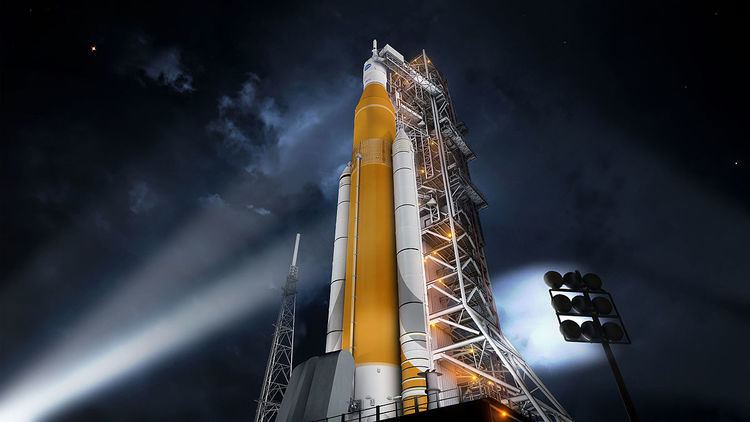Operator NASA/ESA Spacecraft type Orion MPCV | Mission duration 3 Weeks Rocket SLS Block 1 | |
 | ||
Mission type Lunar Orbital Test Flight Launch date September 30 2018 (planned) | ||
Exploration Mission 1 or EM-1 (previously known as Space Launch System 1 or SLS-1) is the first planned flight of the Space Launch System and the second flight of the Orion Multi-Purpose Crew Vehicle. The launch is planned for September 30, 2018 from Launch Complex 39B at the Kennedy Space Center. The Orion spacecraft is planned to spend approximately 3 weeks in space, with 6 days of this in a retrograde orbit around the Moon. It is planned to be followed by Exploration Mission 2 in 2021.
Contents
Overview
The Block 1 version of SLS used on this mission will consist of two five-segment Solid Rocket Boosters, four RS-25D engines built for the Space Shuttle program and an Interim Cryogenic Propulsion Stage. EM-1 is intended to demonstrate the integrated spacecraft systems prior to a crewed flight, and in addition, test a high speed reentry (11 km/s) on Orion's thermal protection system.
On January 16, 2013, NASA announced that the European Space Agency would build Orion's service module based on its Automated Transfer Vehicle, so the flight could also be regarded as a test of ESA hardware as well as American, and of how the ESA components interact with the American Orion components.
The Exploration Flight Test 1 (EFT-1) flight article was consciously constructed in a way that if all the missing components (seats, life support systems) were added, it would not meet the mass target. It was planned that subsequent capsules would be modified to be lighter, based on manufacturing experience.
In January 2015 NASA and Lockheed announced that some components in the EM-1 capsule would be up to 25 percent lighter compared to the previous one. This would be achieved by changes to the primary structure - the EM-1 article would be welded together from 3 panels for the cone, as opposed to 6 panels used for the EFT-1 article. The total number of welds was reduced from 19 to 7, thus saving the additional mass of the weld material. Other savings would be due to revisiting its various components and wiring. For EM-1 the capsule will be outfitted with complete life support system and crew seats, but will be left unmanned. However, in February 2017 NASA announced that Robert Lightfoot, the agency's Acting Administrator, had asked the Human Exploration and Operations Mission Directorate to study the feasibility of redesigning the mission to include a crew.
Crewed Version
At this moment the mission will be unmanned, however NASA has initiated a study to investigate a crewed version of the mission. A crewed version of EM-1 would be composed of a crew of 2 astronauts, and will be much shorter than the unmanned version due to safety reasons. The study investigates a crewed mission launching in mid 2019, a year delay from the current planned launch date.
History
Originally EM-1 was planned to follow a circumlunar trajectory without entering orbit around the Moon.
Secondary payloads
Thirteen low-cost CubeSat missions are to be selected as secondary payloads on the EM-1 test flight. They will reside within the second stage on the launch vehicle from which they will be deployed. Two CubeSats have been selected through NASA's Next Space Technologies for Exploration Partnership, three through the Human Exploration and Operations Mission Directorate, two through the Science Mission Directorate, and three were chosen from submissions by NASA's international partners. The remaining CubeSats are to be chosen in 2017 through NASA's Cube Quest challenge. The spacecraft already selected are:
NASA awarded two CubeSat contracts in March 2015 to Lockheed Martin ($1.4 million) and Morehead State University ($7.9 million) to develop SkyFire and Lunar IceCube, respectively, that could potentially be added to the EM-1 test flight. The remaining three of the eleven SLS launch slots will be filled through a competition pitting CubeSat teams based in the United States against each other in a series of ground tournaments called 'NASA's Cube Quest Challenge'. The remaining winners will be announced at the completion of the fourth and final Ground Tournament in February 2017. This competition will contribute to opening deep space exploration to non-government spacecraft.
Similar missions
Apollo 8 was a similar mission in 1968, crewed by 3 astronauts, designed to flight test a Command Service Module beyond low Earth orbit. It made use of its Service Module engine three times, to enter and leave lunar orbit.
A proposed late 2018 SpaceX lunar tourism mission is similar to EM1, with two space tourists paying for a free-return loop around the Moon and back to Earth, using the Crew Dragon capsule and launched on the Falcon Heavy. At the time of announcement in early 2017, neither this version of the Dragon nor Falcon had yet flown.
